
BRUSSELS, Belgium, June 15, 2021 (ENS) – Environmental concerns, especially about the consequences of climate change, are on the minds of U.S. President Joe Biden and the European leaders he has met with over the past two days.
On Monday, after attending the G7 meeting in the UK, President Biden met with the United States’ NATO allies in Brussels.
Many firsts marked the meeting. This is President Biden’s first international trip since he took office in January. This is NATO’s first summit since 2018, and for the first time, NATO has issued a plan to limit climate change.
In their final statement, the NATO members left no doubt that they are taking climate change seriously as “one of the defining challenges of our times.”
“It is a threat multiplier that impacts Allied security, both in the Euro-Atlantic area and in the Alliance’s broader neighbourhood,” NATO said.
The 30 NATO member countries are: Albania, Belgium, Bulgaria, Canada, Croatia, Czech Republic, Denmark, Estonia, France, Germany, Greece, Hungary, Iceland, Italy, Latvia, Lithuania, Luxembourg, Montenegro, Netherlands, North Macedonia, Norway, Poland, Portugal, Romania, Slovakia, Slovenia, Spain, Turkey, United Kingdom, and the United States.
NATO is clear-eyed about describing a geopolitical landscape packed with threats that are worsened by the planet’s increasing heat. “The effects of climate change shape our geopolitical environment and may influence state behaviour. For example, thawing permafrost, desertification, and the opening up of new shipping lanes are factors that can contribute to increased instability and geostrategic competition,” the statement warns.
“We face multifaceted threats, systemic competition from assertive and authoritarian powers, as well as growing security challenges to our countries and our citizens from all strategic directions,” NATO acknowledges.
Adversaries Abound
“Russia’s aggressive actions constitute a threat to Euro-Atlantic security; terrorism in all its forms and manifestations remains a persistent threat to us all,” the NATO leaders warn.
In his remarks ahead of the meeting, NATO Secretary General Jens Stoltenberg said, “So we see a pattern of Russian behavior, of aggressive actions against their neighbours Ukraine, Georgia. But also cyberattacks, hybrid attacks, poisoning against, including against Allies. And, of course, this is something that has led to the deterioration of the relationship between NATO and Russia, and our relationship is now at the lowest point since the end of the Cold War.”
“But NATO is adapting, NATO is responding,” Stoltenberg explained. “We have already implemented the biggest reinforcement of collective defence, with high readiness, with battlegroups in the eastern part of the Alliance, and increased defence spending every year since 2014.”

Relations between the NATO military alliance and the Russian Federation were established in 1991, and in 1994, Russia joined the Partnership for Peace program, and since then, NATO and Russia have signed several agreements on cooperation.
The Russia–NATO Council was established in 2002 for handling security issues and joint projects. But on April 1, 2014 NATO unanimously suspended all practical co-operation with Russia in response to Russia’s invasion of Ukraine – the Council was not suspended.
Secretary General Stoltenberg is relieved that the challenges of the past four years are at an end. “I welcome the fact that we have a President of the United States who is strongly committed to NATO, to North America and Europe, working together in NATO,” he said. “I met President Biden in the White House this week, and he expressed [an] extremely high level of confidence in our transatlantic bond.”
NATO hopes to engage China in cooperation to limit climate change.
“NATO maintains a constructive dialogue with China where possible,” the members stated. “Based on our interests, we welcome opportunities to engage with China on areas of relevance to the Alliance and on common challenges such as climate change.”
“Reciprocal transparency and understanding would benefit both NATO and China,” the statement says, while warning that, “proliferation of weapons of mass destruction and the erosion of the arms control architecture also undermine our collective security.”
Space and Cyberspace at Risk
“We are increasingly confronted by cyber, hybrid, and other asymmetric threats, including disinformation campaigns, and by the malicious use of ever-more sophisticated emerging and disruptive technologies,” NATO said. “Rapid advances in the space domain are affecting our security.”
“Climate change is a threat multiplier that impacts Alliance security,” NATO stressed. “The greatest responsibility of the Alliance is to protect and defend our territories and our populations against attack, and we will address all threats and challenges which affect Euro-Atlantic security.”
The NATO member states have agreed to “significantly reduce greenhouse gas emissions from military activities and installations without impairing personnel safety, operational effectiveness and our deterrence and defence posture.”

The member states have invited Secretary General Stoltenberg to formulate “a realistic, ambitious and concrete target for the reduction of greenhouse gas emissions by the NATO political and military structures and facilities and assess the feasibility of reaching net zero emissions by 2050.”
In their comminuque, the NATO members point out that climate change makes it muc more difficult for military forces to carry out their duties.
“Greater temperature extremes, sea level rise, rapid changes in precipitation patterns, and an increasing frequency and intensity of extreme weather events test the resilience of our military installations and critical infrastructure, impair the effectiveness of our capabilities, and may create harsher conditions for our military operations and missions.”
As the climate warms and drought, soil erosion and marine environmental degradation spread across the world, NATO warns that famine, floods, loss of land and livelihood, impacts on women and girls, poor, vulnerable and marginalized populations will follow.
NATO members worry that land and water degradation can “exacerbate state fragility, fuel conflicts, and lead to displacement, migration, and human mobility, creating conditions that can be exploited by state and non-state actors that threaten or challenge the Alliance.”
Building Back Better With the European Union
“America is back. We are committed – we have never fully left – but we are reasserting the fact it is overwhelmingly in the interest of the United States to have a great relationship with NATO and with the EU,” Biden said as talks began today with EU leaders “I have a very different view than my predecessor.”
In their statement at the end of the meeting, the EU and the US leaders agreed to “protect our planet and foster green growth.”

“Climate change, environmental degradation, and the loss of biodiversity are mutually-reinforcing, extraordinary threats to humanity. We plan to continue and strengthen our cooperation to tackle climate change, environmental degradation and the loss of biodiversity, promote green growth, protect our oceans, and urge ambitious action by all other major players,” they pledged.
The European Union and the United States committed to establish a U.S.-EU High-Level Climate Action Group.
“We intend to lead by example through becoming net zero greenhouse gases (GHG) economies no later than 2050, they said, vowing to “engage our international partners to achieve an ambitious outcome at the 26th UN Climate Change Conference of the Parties (COP26), “making every effort to keep a 1.5 degree Celsius limit on global temperature within reach.”
The Paris Climate Accord sets a goal of keeping the planet’s temperature increase to 2 degrees Celsius above pre-industrial levels, with an aspiration to keep it below 1.5 degrees Celsius.
“In order to fulfill the objectives of the Paris Agreement, we stress that international investments in unabated coal must stop now and call for global efforts to phase out unabated coal in energy production,” the US and EU leaders urged today.
They resolved to “take concrete steps towards an absolute end to new direct government support for unabated international thermal coal power generation in third countries by the end of 2021, including through Official Development Assistance, export finance, investment, and financial and trade promotion support.”
“We are determined to accelerate a climate-neutral future and ensure a just transition that leaves no one behind,” the US and EU leaders said, and they plan to achieve that future through low greenhouse gas emission technologies, an increasing uptake of renewable energies, promoting clean energy innovation, energy efficiency and methane emissions reduction, sustainable food systems, including climate-smart agricultural systems, as well as sustainable and smart mobility.
We commit to rapidly scaling up technologies and policies that further accelerate the transition away from unabated coal capacity and to an overwhelmingly decarbonized power system in the 2030s, consistent with our respective 2030 NDCs and 2050 net zero commitments.
The U.S.-EU Energy Council will continue to lead coordination on strategic energy issues, including decarbonization of the energy sector, energy security, and sustainable energy supply chains.
We resolve to increase our cooperation on transition towards a climate-neutral, resource-efficient and circular economy. In this context, we intend to work towards a Transatlantic Green Technology Alliance that would foster cooperation on the development and deployment of green technologies, as well as promote markets to scale such technologies.
We intend to continue to scale up efforts to meet the US$100 billion per year climate finance goal through to 2025, to fund meaningful climate mitigation and adaptation action.
30 Percent of Lands and Oceans to Be Conserved
“We are strongly determined to halt and reverse biodiversity loss by 2030 and take urgent action to address its drivers. In this context, we are committed to the goal of conserving or protecting at least 30 percent of the global land and 30 percent of the global oceans by 2030,” US and EU leaders pledged.

They committed to conserve or protect at least 30 percent of their own land, including terrestrial and inland waters, and coastal and marine areas by 2030, according to national circumstances and approaches, a goal that President Biden had announced for the United States earlier this spring.
They intend to step up cooperation on deforestation and wildlife trafficking and “plan to jointly promote a successful and ambitious post-2020 global biodiversity framework at the 15th UN Biodiversity Conference of the Parties (COP15).
We also encourage partners to join multilateral efforts at the UN Environment Assembly to consider next steps at the global level to tackle plastics pollution.
We commit to working together to protect our oceans, including by combatting marine litter. We resolve to support the designation of new marine protected areas in the Southern Ocean, and continue cooperating for the purpose of the sustainable blue economy, sustainable fishing, prevention of Illegal, Unreported, and Unregulated (IUU) Fishing, and research through the All-Atlantic Ocean Research alliance.
We will also plan to work together at the next UN Ocean Conference and at the intergovernmental conference on Marine Biodiversity beyond National Jurisdiction.
Finally, the governments agreed to “grow the U.S.-EU trade and investment relationship as well as to uphold and reform the rules-based multilateral trading system. We intend to use trade to help fight climate change, protect the environment, promote workers’ rights, expand resilient and sustainable supply chains, continue to cooperate in emerging technologies, and create decent jobs.”
Featured image: NATO leaders in a family photo at NATO headquarters in Brussels, June 15, 2021 (Photo courtesy NATO)



